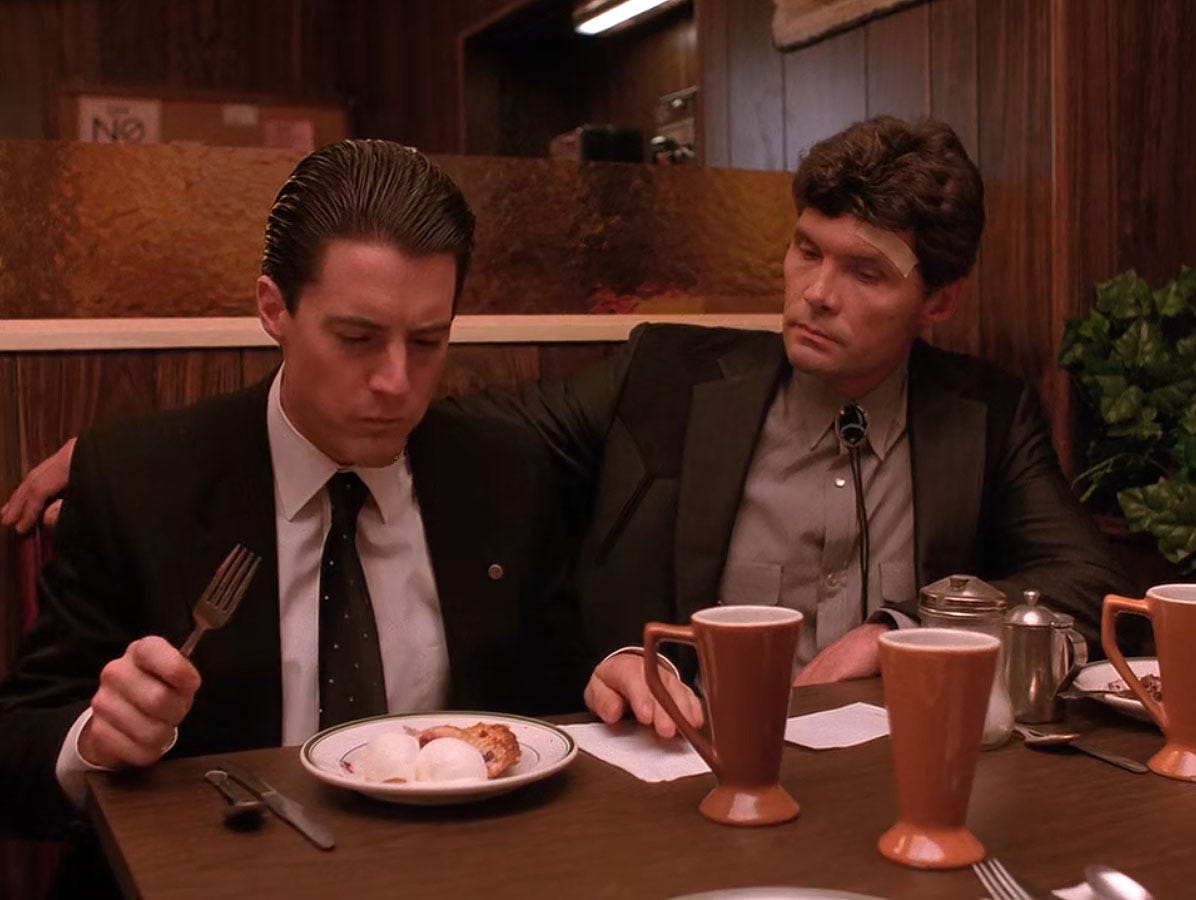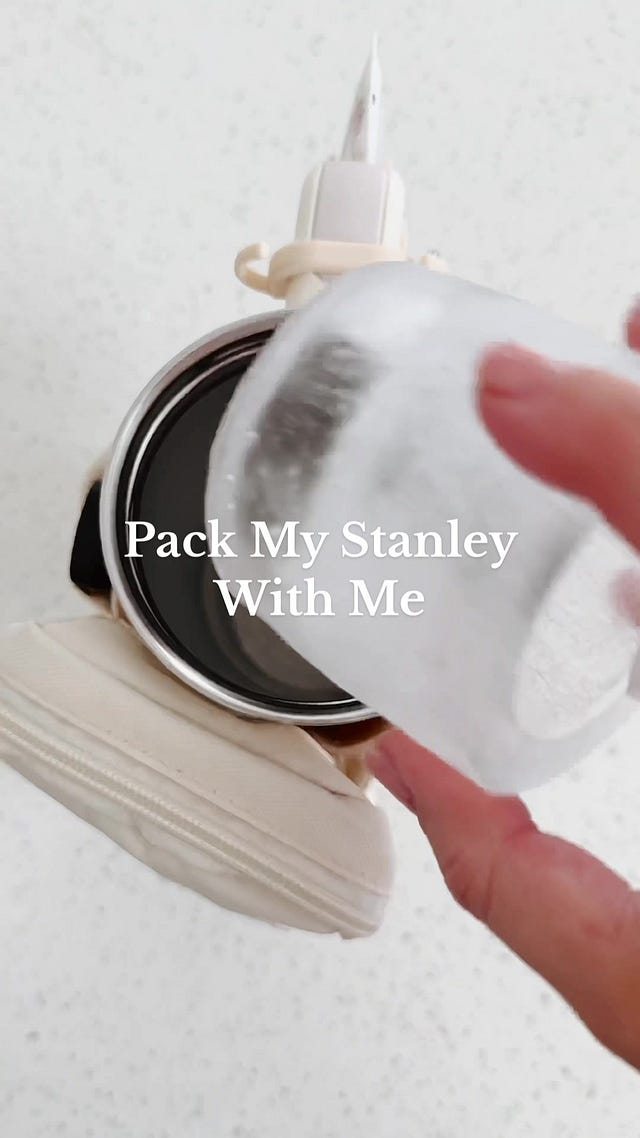◡◶▿ TIME03 | The hero's cake
🍰 Flavouring your movie with the maraschino cherries of Time. Plus: Funding for noobs; Stanley cup as cinema's tombstone. | New Systems of Time Week 3
📹 Unfound Peoples Videotechnic | Cloud-based filmmaking thought. ☁️

Sorry I’m late for class. The mailing system was down this morning. It’s up again now. Great! And special apologies to all those students in the Americas who get up at 4.15am or earlier on a Monday to read my morning email. Sorry!
Dear eternal filmmaking students,
Okay! Hi. Down below today’s lesson, you can read:
why a fashionable cup heralds the death of cinema, and
how to access several thousand pounds in funding if you’ve never made a movie and have not yet written your script.
Great!
But first, here’s a recap of last week’s lesson, Movies for airports. We learned how:
Long before the little clocks on the front of VHS players, people used burning incense or dripping water to follow the time.
The hypnotic/dazzling power of cinema was implicit in the play of light and sound of these ancient timepieces.
There’s no good reason why you can’t program your characters and their props to tell contemporary audiences the time just as hypnotically.1
True ambient narrative film should be both useful and ignorable.
Missed a week? Joined late? Don’t worry about reading these lessons out of order. Each functions independently. They are sent in a sensible sequence but hardly reliant on it.
Good. And this week? Let’s see how:
🍰 Your movie is made up of slices - visual, narrative, and temporal slices.
🧇 This cross-section look at your hero’s world reveals patterns we miss in our daily lives
👩🍳 Movies are not real life, so messing with the recipe of this ‘marble cake’ structure can cook up curious new cinematic possibilities.
🔪 The filmmaker lets her hero see the cake slice at her own risk.
Great. Let’s crack on with week three of New Systems of Time.
The hero’s cake
You can hear me deliver this lesson by scrolling up to the header and clicking Listen and/or the play ▸ button.
In terms of the space and time a narrative movie occupies, it can be considered a slice or slices of life:
A photon-thin sliver of recorded activity on the wall.
A cross-section of the hero’s day, week, or life.
The cross-section may be more or less representative of the day, week, or life.
chosen at random, or
at clinically-selected intervals,
The filmmaker’s selection of moments-of and angles-on an imagined world.
Extracted to convey a particular story or feeling in a particular way.
A movie is sliced this way or that, or this way and that.
This sliciness presents multiple cross-sections of the hero’s world to view.2 A chance to trace rhythms or narratives that might otherwise get lost in the cake. (More often than not, the movie is sliced to expose one particular, primary narrative.)
Perhaps this is satisfying because it helps the audience to trace patterns of causality that are more difficult to identify in their so-called real, or daily lives.
Certain patterns of causality are difficult to trace in our daily lives, because:
We are in the middle of the cake - we are ‘of the slice.’
The universe is infinitely complex: butterflies flap wings, synapses fire.
(Our instinct to blame muddies the whole arrangement, too.)
But more adventurous filmmakers may include scenes or sequences that are not a strict continuation of the narrative’s flat cross-section. We may think of this as ‘dislodging a berry.’
Such berries, baked into the ‘cake,’ are discrete, springy, and self-contained but for a slight leak of coloured juice into the surrounding sponge. Their bulk and essence evade the slice of a blunt knife. And protrude beyond the ideal surface.
If it is dislodged and falls out, whole, the berry changes the whole hierarchy of the plate. The whole experience and understanding of the film, the hero’s universe, and his place in it. (This is the temporal equivalent of retrofitting an empty filler area in a movie’s set design.3)
Remember, the characters in such a structure are ‘of the slice.’ They cannot conceive of the berry’s existence, let alone the whole cake. However, if that leaked juice along the cross-section is caused by the knife (rather than the baking process), the hero is confronted by a mediaphysical rupture. The fact of being a movie character comes up against the hero’s experience of time. He must manage his experiences against the tang of leaking meta-temporality.
At this point, the analogy, and the cake, fall apart. And the filmmaker should pick at the crumbs, with a cup of tea, hovering slightly outside of narrative time.
Please share your thoughts, queries, and exercises from this week’s lesson in the comments.
Snakes & funerals vs. Giraffes & spaceships
Remember last week’s bombshell about the death of “plot-based media” and the TikTokification of narrative?
Well, today, I’ll direct you towards a piece that mourns the death of landscape orientation aspect ratios. Author Kelly Pendergrast traces the rise of the ‘Stanley cup’ TikTok video as living (portrait orientation) tombstone for the landscape-orientation period.
Stanley cup-themed videos are now ubiquitous on social media. And these stainless steel travel mugs fit the shape of your phone screen as neatly as “snakes and funerals” fit the CinemaScope sprawl. For Pendergrast, they’re emblematic of verticality’s triumph. You now look dafter telling someone to turn their cameraphone sideways than you do filming with one longways.
And the “sequential micro-narrative (non-)structure of the feed” favoured by the TikTok generation echoes through the jump cut grammar of the individual TikTok video. This jump cut grammar is necessary because the portrait format doesn’t leave visual space for continuity editing (except, perhaps, for giraffes and rocket launches). “[M]eaning occurs by accretion,” notes Pendergrast, as “Stanley accessories pile on, one disconnected fragment after another.”
(The first example that popped up when I searched.)
TikTok grammar benefits from a “transitional object” (as clung to by children experiencing separation anxiety) such as the Stanley. The cup gives at least some continuity from shot to shot. Reassuring you through the trauma of the cut; perhaps reassuring us all through the trauma of cinema’s death.
Cheers! 🥤
Biscuits and a hug and £3-5,000
Here’s a nice fund for debut feature film or ‘immersive work’ writers in England: the BFI NETWORK England’s Early Development Fund offers “£3,000 to £5,000 to develop a treatment.”
They say that the “funding supports the early stages of development for debut long-form projects. It directly supports writers who do not yet have the first draft of a script.”
In other words: if you’ve done nothing and are not quite ready to do something yet, this is for you. I think we all feel a little like that. The funding should come with biscuits and a hug. Biscuits and a hug!
Next week: temporal expressionism!
I’ll leave you to it. 🍰 ☕
Class dismissed!
~Graeme Cole.
(Principal)
P.S. Here’s this week’s themed song recommendation.
🦋 Bluesky | ⏰ TikTok | 📸 Instagram | 😐 Facebook | 🎞️ Letterboxd | 🌐 unfound.video
(My six-year-old daughter doesn’t read these newsletters. But strangely, since last week’s class on making a movie that functions as a clock, she’s begun a series of paintings to be swapped throughout the day to mark the passing time. I somehow have to wake up before everyone else to hang the ‘alarm clock’ painting first thing in the morning.)
This apparent ‘sliciness’ is actually reverse-engineered: the filmmaker does not (cannot) make the whole cake. (Though they may imagine or sketch other parts of it during pre-production. And almost always take other slices which don’t make it to the final plate.)
“A filler area is an unimportant, unseen place in the diegesis of a film. A blank on the map. You might find one beyond an unopened door or over the horizon.” Read more on that.






